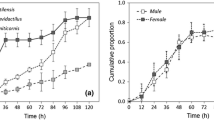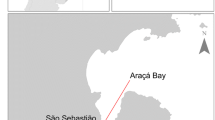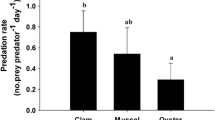Abstract
Simulated gastropod predation sites were observed in the gulf intertidal near the Edward Ball Marine Laboratory, Sopchoppy, Florida,Fundulus similis, Callinectes sapidus, Melongena corona, Clibanarius vittatus, andPagurus longicarpus were attracted to the sites by small molecules released passively from the flesh of wounded or dead animals. Flesh consumers (F. similis, C. sapidus, andM. corona) were attracted to molecules released from the flesh of bivalves, gastropods, and crabs. Shell users (C. vittatus andP. longicarpus) were attracted only to small molecules from gastropod flesh, withP. longicarpus attendingP. duplicatas sites whileC. vittatus preferentially attendedM. corona, Busycon contrarium, andBusycon spiratum sites. Flesh consumers and shell users may be attracted to the sites by different sets of small molecules. The addition of proteolytic enzymes to the flesh increased the attendants at a site, indicating that the attractant molecules might be amino acids or small peptides. Flesh consumers were attracted to the sites primarily in the first 12 hr while the shell users were attracted from 2 hr to several days postinitiation. New shells were attractive to hermit crabs up to 12 hr after entry by a hermit crab. The shell species of the attendantC. vittatus were in different proportions than the generalC. vittatus population, and the shell fit of theP. longicarpus attendants was not as good as the general population ofP. longicarpus. Significantly moreC. vittatus attended than P. longicarpus, and it was speculated that there were moreC. vittatus in the area with a poor shell fit thanP. longicarpus.
Similar content being viewed by others
References
Ameyaw-Akumfi, C., andHazlett, B.A. 1975. Sex recognition in the crayfish,Procambarus clarkii.Science 190:1225–1226.
Atema, J. 1978. Chemical senses, chemical signals, and feeding behavior in fishes. Proceedings of workshop on fish behavior and its possible applications in management and fisheries, Bellagio, Italy, November 1977. Bardach, Magnuson and May, (eds.) Int. Center Living Aq. Res. Man. Mannila, Philippines, (in press).
Atema, J., andBurd, G. 1975. Afield study of chemotactic responses of the marine mud snail,Nassarius obsoletus.J. Chem. Ecol. 1(2):243–251.
Atema J., andEngstrom, D.G. 1971. Sex pheromone in the lobster,Homarus americanus.Nature (London) 232:261–263.
Atema, J., andStenzler, D. 1977. Alarm substance of the marine mud snail,Nassarius obsoletus: Biological characterization and possible evolution.J. Chem. Ecol. 3(2):173–187.
Bach, C., Hazlett, B.A., andRittschof, D. 1976. The effects of interspecific competition on the hermit crabs,Clibanarius tricolor.Ecology 57:579–586.
Bardach, J.E. 1975. Chemoreception of aquatic animals, pp. 121–132,in D. Demon and J. Coglan (eds.). Olfaction and Taste, Vol. V. Academic Press, New York.
Frotheringham, N. 1976. Effects of shell stress on the growth of hermit crabs.J. Exp. Mar. Biol. Ecol. 23:655–671.
Gore, R.H. 1966. Observations on the escape response inNassarius vibex (Say) (Mollusca, Gastropoda).Bull. Mar. Sci. 16:423–434.
Hazlett, B.A. 1966. Social behavior of the Paguridae and Diogenidae of Curacao. Studies on the fauna of Curacao and other Caribbean islands. 23:1–143.
Hazlett, B.A. 1975. Ethological analyses of reproductive behavior in marine Crustacea.Pubbl. Staz. Zool. Napoli 39(suppl):677–695.
Jahan-Parwar, B. 1975. Chemoreception in gastropods, pp. 141–146,in D. Denton and J. Coglan, (eds.). Olfaction and Taste, Vol. V. Academic Press, New York.
Laverack, M.S. 1975. Properties of chemoreceptors in marine Crustacea, pp. 141–146,in D. Denton and J. Coglan, (eds.). Olfaction and Taste, Vol. V. Academic Press, New York.
McLEAN, R.B. 1974. Direct shell acquisition by hermit crabs from gastropods.Experientia 30(2):206–208.
McLean, R.B. 1975. A description of a marine benthic faunal habitat web. Doctoral dissertation, Florida State University, 109 pages.
Reese, E.S. 1963. The behavioral mechanism underlying shell selection by hermit crabs.Anim. Behav. 21:78–126.
Stenzler, D., andAtema, J. 1977. Alarm response of the marine mud snail,Nassarius obsoletus: Specificity and behavioral priority.J. Chem. Ecol. 3(2):159–171.
Author information
Authors and Affiliations
Rights and permissions
About this article
Cite this article
Rittschof, D. Chemical attraction of hermit crabs and other attendants to simulated gastropod predation sites. J Chem Ecol 6, 103–118 (1980). https://doi.org/10.1007/BF00987531
Received:
Revised:
Issue Date:
DOI: https://doi.org/10.1007/BF00987531




